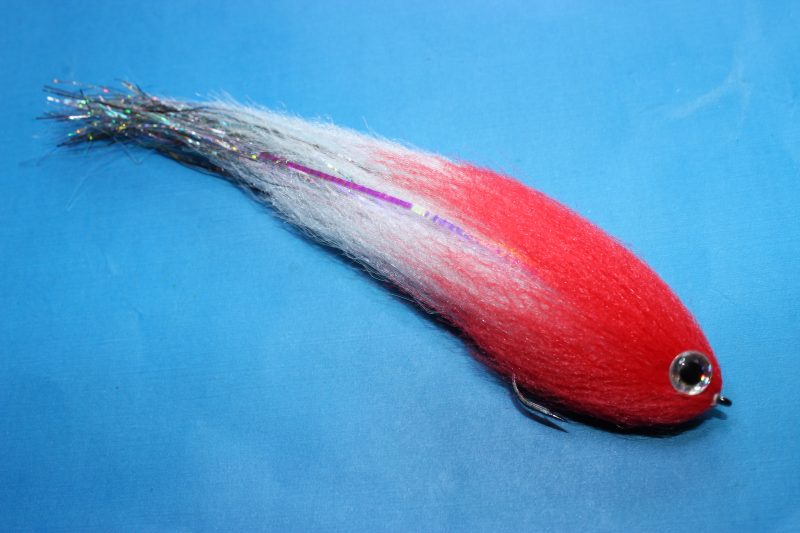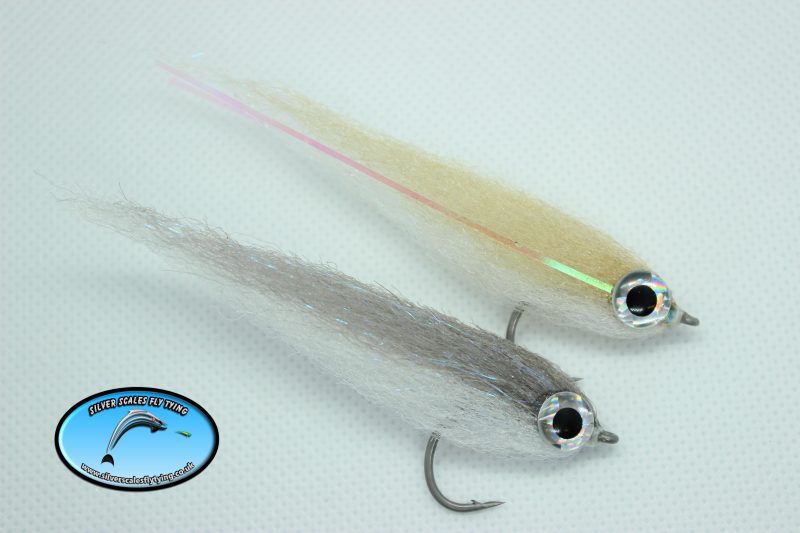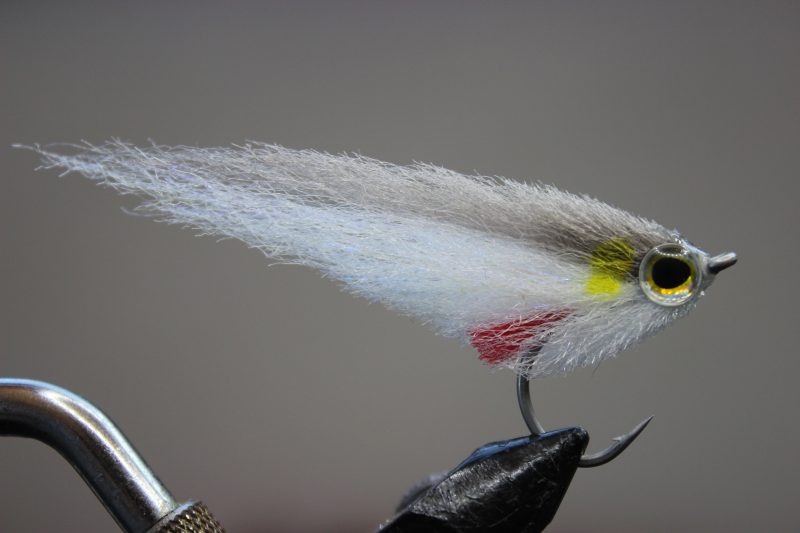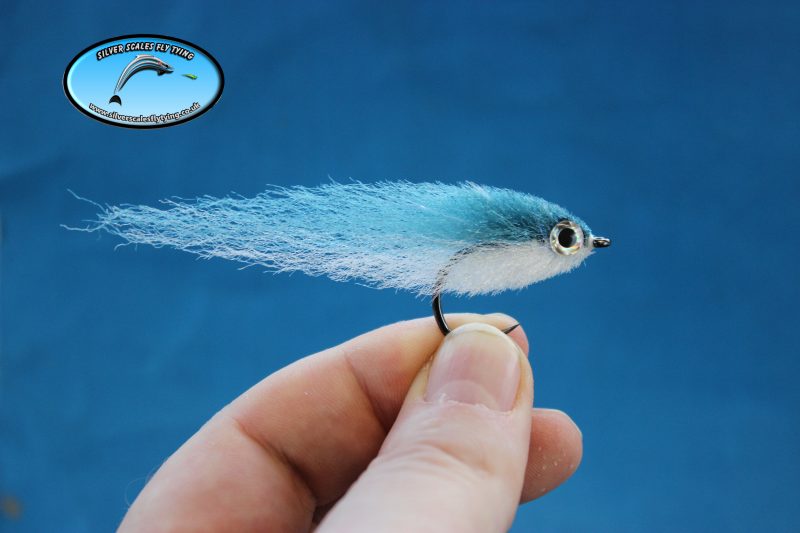I’ve had this Article going around in my head for some time now, so lets tackle some of the more technical points of tying flies for Predators focusing on Baitfish patterns.
For the beginner fly tier this article may only serve to make the prospect of tying their own flies a more daunting prospect, however I would suggest that they give it a read and make note of the points raised and then come back to it at a later date once they understand and have mastered the more basic processes and are looking to improve.
So, we all want to tie effective flies for catching those Predators, but how much thought goes into your own fly designs? What considerations drive which patterns you tie? It may be that you are happy to copy an established or proven pattern. You may decide to tie your own creations from your own imagination. There is nothing wrong with either of these options and in truth I always maintain there isn’t a fly our there that won’t catch fish at some point no matter how expertly or how poorly tied it may be. Predatory fish Like Pike, Perch, Bass, Pollock etc. don’t have time to examine our offerings before snapping them up. They either eat or go hungry, it’s a very simple equation. As long as our fly looks remotely like something that will make a meal they will have a go. Most of the time. Yes the previous statements are a generalisation because there are times when it can be hard to tempt a bite. It’s these times that looking more closely at certain aspects of fly design can reap rewards when things get difficult.
Like just about every fly tier on the planet I began tying basic patterns that I had seen on the internet. Being primarily a Saltwater fly angler pursuing Bass, Pollock, Mackerel and Garfish around the coastline of my home here on the Island, I naturally began tying the classic fly patterns such as Clousers, Deceivers, Ray’s fly and Surf Candies. Nothing wrong with any of those and they are all effective fish catchers, and indeed I caught many fish using them. If ain’t broke don’t fix it? Well yes, but if we stand still we stagnate? I wanted to broaden my horizons and to be honest I didn’t feel I was fairly representing the prey fish that my target species were looking for and I felt that if I could, I would be able to maximise on the opportunities when they came along. Coastal fly fishing, especially in the UK can be a hard old game so when you put in the amount of effort that’s needed to locate the fish you need to be sure you are giving yourself the best chance of catching. Of course the same goes for The Pike and Perch fly angler, there is always room to improve your chances of catching and maximising when the opportunities for a red letter session presents itself.
It was then that I took a liking to the Baitfish style patterns. With this type of design it was possible to create something that looked far more ‘fish like’. After many hours of practice, little by little I began to master the techniques involved in achieving the type of profile I was looking for. Nowadays this type of fly is the staple of my fly box and includes a range of colours and sizes of fly that I feel will cover my needs throughout the season and imitates effectively the wide spectrum of prey species that the Predators are feeding on as well as the varying conditions that may be encountered, such as coloured water and shallow and deeper venues. I have adapted the original designs somewhat for Coastal work as most Baitfish patterns were originally intended for inland waters and targeting Pike. My Baitfish patterns are more streamlined and contain significantly less material than a similar Pike version might. In my own patterns, surprisingly for most Pike anglers I am not actually looking for much inherent movement from the fly. As I am mostly fishing in current in the form of tidal flow, I prefer any movement to be quite subtle. In the Ocean, fish use the tide to traverse from place to place, in fact most of the time they are simply swept along with it, only expending energy and actually swimming freely when absolutely necessary. Even when facing into current, depending on the strength of the flow they will exhibit very little movement. Nature designed them that way, they are virtually hydro-dynamically perfect. For the most part any ambush predator will prefer to lie in wait in an advantageous position, waiting for food to come to them in preference to actively chasing it around. In the sea they will lie to one side of any current, out of the main flow and simply dart out and into the current to attack a meal, whereupon they will return to the same position to eat their catch and realign ready for the next opportunity. There are times however when the opportunity presents, that they will actively chase prey, such as when there are large shoals of tiny baitfish and the gluttonous reward is worth the effort. Such a shoal could potentially contain thousands if not tens of thousands of tiny meals. In this instance it is common to see the tiny fish erupting on the surface as the Bass or other predators attack from below, often working in shoals themselves to herd the prey into areas where they are unable to escape easily from. These same two scenarios exist for the River Pike and perch angler. Fish resident to rivers will lie in ambush out of the main flow waiting for an easy meal to sweep past them. They will also use the flow to traverse from place to place. They will herd baitfish into slack areas working together to keep the food in one place. Stillwater residents however are also faced with another scenario. They must expend energy and move from place to place under their own steam looking for feeding opportunities. Their movements are still often subtle though, stalking their prey and using structure to hide themselves in conjunction with their natural camouflage. Their prey tend to be more active. If you have ever watched a shoal of Roach or Rudd and even Bream, they are rarely motionless, often swimming and darting around, flanking and flashing. When you’re in a shoal there is safety, but there are also more mouths to feed, so competition for small morsels of food can be fierce, hence this behaviour that keeps them on the move.
I’ve outlined a few scenarios there and each one will require a different approach and will influence fly choice so let’s look at this a bit more closely.
I mentioned that for my own fishing on the coast, I am mostly looking for hardly any inherent movement from my flies. Any movement in the fly has to be quite subtle if I am to imitate the the shoals of prey fish traversing on the tide. For the most part the marks that I fish are populated by small Pollock, Mullet and Smelt as well as small Bass that are Preyed on by their larger cousins. It is these species that I am attempting to match the hatch to when tying my flies. I have been particularly successful in recent years with flies tied to imitate Mullet. A simple grey back over a white belly and a yellow spot behind the silver and black eyes is a fair representation of a Golden grey mullet. The fly is tied in such a way that it has a streamlined, rounded body profile and will simply be cast ‘upstream’ in any tidal flow and be allowed to be swept along whilst making smooth slightly erratic strips on the line. The fly will not dart and jerk all over the place but sit more or less steady in the current, appearing to ‘glide along’. Hopefully at some point there will be a Bass lying in wait, this could be behind a weed bed, or a rock or some kind of man made structure that is disrupting the flow slightly and providing the predator with the necessary cover and ambush point. The Bass has the advantage and as my fly is swept along it will break cover and engulf my offering at the optimum moment. From the Bass’ point of view my fly was behaving as it would expect and merely appeared like another small Mullet allowing itself to be propelled by the current towards it’s destination, probably it’s own muddy feeding grounds somewhere nearby. In one way I had very little to do with the Bass’s decision to eat the fly, but on the other hand I had everything to do with it. I wasn’t imparting any movement into the fly to try and make the Bass strike, but simply allowing it to behave naturally by doing virtually nothing, which in this scenario is exactly what was expected of it.The next scenario is when we encounter a ‘blitz’. This is when there is an abundance of small baitfish shoaled up. Around the Island this can be a common site during the summer, although the feeding frenzy may not always be within reach of a fly. When it is however, sport can be fast and furious with the main cuplrits being Bass and Mackerel. The same tidal currents that allow the Predators to move from place to place can also be turned to their advantage and used to herd these vast shoals of tiny food into areas where they can easily be preyed upon. These small fish are unable to swim against the current and are often at the mercy of it becoming disoriented and vulnerable to attack. Lets assume we have come across such an opportunity and we have a ‘blitz’ occurring withing range of a fly cast. In this instance we have hundreds of tiny baitfish erupting from the surface of the water, and this same event can often be found inland in freshwater fisheries during the autumn and winter as Perch, the freshwater cousin of Bass, take advantage of shoals of tiny fry seeking shelter during the colder months. In both instances they are moving frantically trying to escape the cavernous doom that awaits them if they are eaten. Here it would be preferable to have a fly with lots of movement. The reason being is that we are competing with a large number of other food items all desperately trying to escape being eaten and therefore we need our fly to stand out in the crowd. It can be frustrating encountering a feeding frenzy and not being able to get a bite. I know, I have had it when I’ve made the wrong fly choice, continually casting into a frenzied shoal of Bass or Mackerel and frustratingly not being able to get a hit from any of them. In this situation I needed a Fly with lots of movement. A small Clouser is often the best choice I have found when faced with a feeding shoal. As long as the colours are near enough, and we get a variety of species of fry around the Island during the summer, the erratic up and down jigging movement of the Clouser created by the metal dumbell eyes will normally get the fish’s attention. In fact throw in the odd pause in stripping so the fly falls through the water and this is when you’ll get a hit. So there’s another way that fly design is a consideration and in fact the materials you tie it with as well as the size of dumbell eyes will affect how quickly or slowly the fly will fall at during that all important pause in the strip. It pays to experiment as much as possible, even a tiny difference can affect the fish’s decision as to whether to take the fly or not. Although I have stated that they will rarely pause to study the fly, especially during a feeding frenzy it may just be enough to make them hesitate so why take the chance?
Occasionally I have encountered Bass in water with little or no flow. This is another scenario where I would choose a fly with some movement. Again they are often not free swimming but laid up next to a weed bed or lurking behind some other kind of structure, a rock or man made structure. In this instance I will choose a fly that has a little weight so it fishes close to the bottom as this is where the Bass will prefer to sit.Unlike in the previous example though I don’t want a fly that jigs with an up and down movement. What is preferable is that the fly has a side to side movement. This is where we begin to look at hydrodynamics when considering fly design. In other words how the water flowing over the fly affects it’s movement and what we can do to dictate that movement. Similar in principle to aerodynamics where the air flowing over an object such as a car or aeroplane affects how cleanly it might cut through the air, or how much lift or downforce it may put on that particular vehicle. A lot of Pike fly anglers also talk about getting the fly to ‘push water’ but I’ll get onto that later. Going back to the present scenario, I have chosen a small Mullet pattern from my box, It’s different from the one I would use in current in profile being quite a tall flat sided pattern similar to an EP style fly. The one used in current is rounder in profile. The pattern I’ve chosen also has a head that has had some UV resin added to the fibres when attaching the eyes. This gives it a stiff almost solid, flattened ( vertically ) head. When stripped the water flowing over the stiffened flattened head causes it to dart subtly from side to side when stripped. It’s a very simple concept and design but it works in making the fly look like a swimming Mullet. I cast past the weed bed and begin stripping the fly with short but not too sharp, strips. The fly makes small darts from side to side just off bottom and is inhaled by the waiting Bass as it passes it’s lair. Another example of designing and choosing the right fly for the situation.
Now that I’ve broached the subject of Hydrodynamics I will move on to Pike flies.
I mentioned that a lot of experienced Pike anglers will talk about getting the fly to ‘push water’. What’s meant by this is designing the head of the fly in such a way that, as it is stripped, it will force the water in front of it and sufficiently over the head to create a kind of ‘wake’ creating not only movement in the fly but also possible micro vibrations through the water. This again is hydrodynamics at works. This is achieved by building a bulky head on the fly with denser materials than used on the rest of the fly. I have also found it possible that by using the right materials in the head you can get the fly to wobble and roll, similar to how an injured or dying fish might. Of course you can create additional movement by using all manner of materials in the tail section of the fly. A popular design for pike flies is to tie in some longer sparse materials along with feathers and flash which kind of wafts around and coupled with a well designed head will make for a fly with some very effective moves. The shape of the head will again dictate the type and amount of movement in the fly as it is stripped through the water. All this is of particular importance when targeting still or slow moving water Pike. The more movement you can build into the fly the more effective it is likely to be. Sometimes it can be frustratingly evident that the Predators just don’t want to feed and it is often said that the right fly can trigger an attack simply out of annoyance rather than hunger. Something to definitely consider when designing and experimenting with Pike fly designs. Sometimes as with the coastal fishing it is a case of ‘matching the hatch’ and a more natural pattern may be the order of the day. A simple Roach pattern without much inherent movement may score over the twelve inch articulated mega fly! On a river with a decent bit of current a nice natural looking Roach drifted on the current and into that slack with an overhanging bush could just see a big old Croc saying thankyou very much!
So to summarise there is more to consider when tying flies than just whipping some materials to a hook. Look at what your target species is feeding on and maybe try and match the hatch. Study how the prey fish are behaving and if possible observe them being preyed on, something may become obvious that can be built in to your flies. Consider the environment you’re fishing and again how the prey fish behave as well as the predators. How they move about, do they stalk their prey or prefer to wait for their food to come to them? If you are looking for your fly to move in a particular way look for materials or techniques when tying them to help you achieve that. The most important thing to remember is to use the right fly in the right situation, obvious maybe but if you don’t have the right fly for the job in your box in the first place you may not be able to maximise on the opportunity. Looking at my own venues, studying the prey fish behaviour and that of the their predators and adjusting my own fly designs to suit has definitely made a difference to my results in the last few seasons. I’ll continue to learn and evolve my flies as necessary to suit the varying situations that I come across in future.




